Understanding the Power of a Cover Letter
In the competitive realm of social media marketing, a well-crafted cover letter is not just an optional extra; it’s a crucial tool that can significantly boost your chances of landing your dream job. It’s your opportunity to introduce yourself to potential employers, showcase your unique skills and experience, and express your genuine enthusiasm for the role and the company. Unlike a resume, which provides a snapshot of your professional history, a cover letter allows you to tell your story, highlighting how your specific qualifications align with the job requirements and company culture. Ignoring this vital component means missing a chance to make a strong first impression, potentially overlooking the opportunity to connect with the hiring manager on a personal level, and demonstrate your passion for social media marketing.
Why a Cover Letter Matters for Social Media Marketing
A cover letter is especially important in social media marketing because it allows you to go beyond the basics presented in your resume. This field is all about communication, creativity, and understanding the nuances of different platforms. A cover letter provides the space to demonstrate your writing skills, express your understanding of the company’s brand, and show how you can contribute to its social media strategy. Furthermore, it’s an opportunity to showcase your personality and passion, which are essential qualities in social media marketing roles. Through your cover letter, you can convey your genuine interest in the company and the specific role, setting yourself apart from other applicants who may only submit a resume.
Showcasing Your Social Media Skills
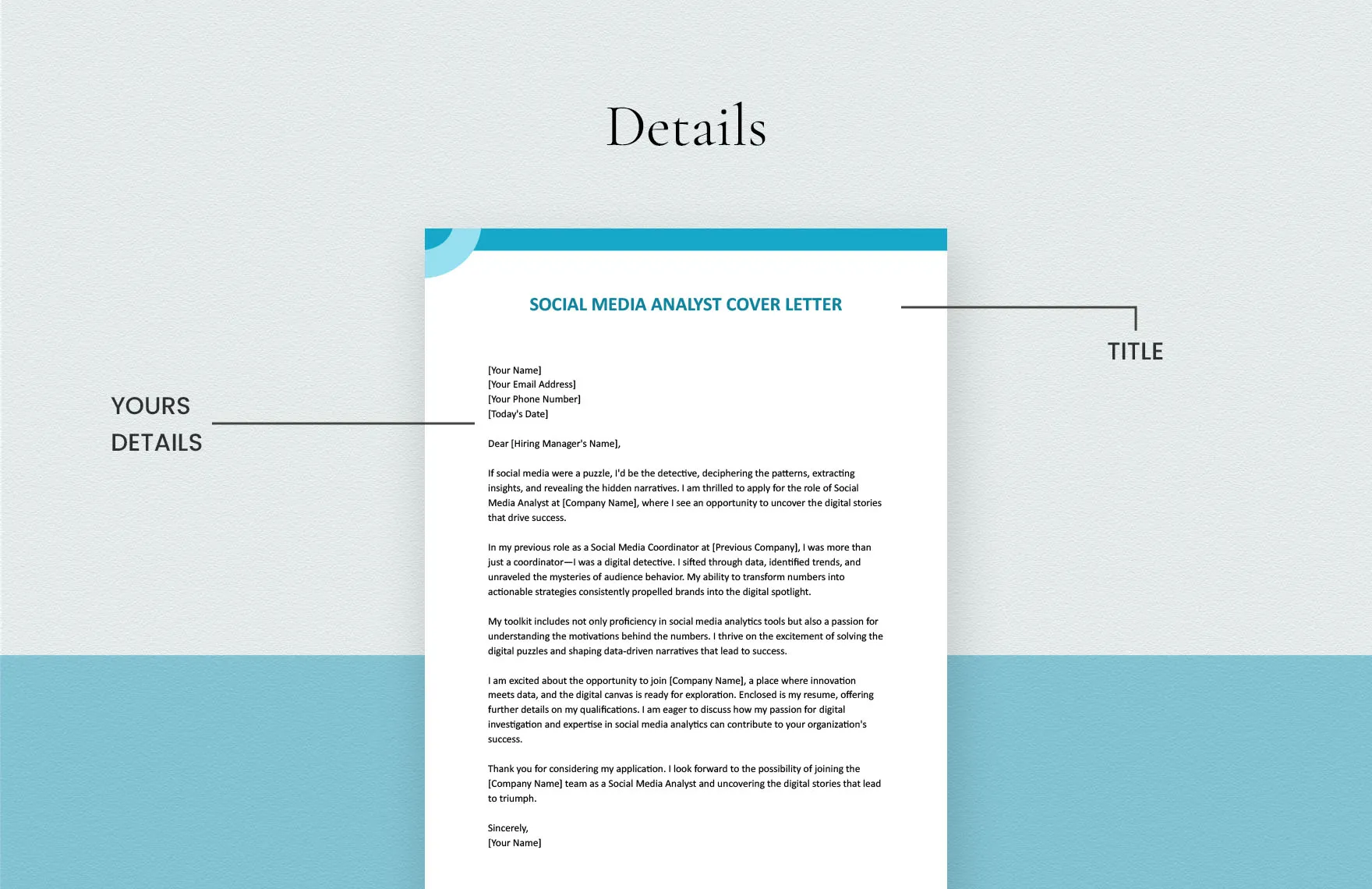
When crafting your cover letter, the key is to highlight your relevant social media skills. Think about the specific platforms you’re proficient in—Facebook, Instagram, Twitter, LinkedIn, TikTok, etc.—and mention your experience with each. Detail your proficiency in content creation, including writing engaging captions, creating visually appealing graphics, and producing videos. Also, demonstrate your understanding of social media analytics and your ability to use data to inform strategy. Mention your experience with scheduling tools, social listening tools, and any other relevant software. Be sure to provide specific examples of how you’ve used these skills to achieve positive results in past roles or projects.
Highlighting Relevant Experience
Your cover letter should clearly outline your relevant experience. Even if you’re an entry-level candidate, emphasize any internships, volunteer work, or personal projects that showcase your social media marketing abilities. If you have previous experience in the field, be sure to highlight your responsibilities and accomplishments. Explain the types of social media campaigns you’ve managed, the audiences you’ve targeted, and the tools and strategies you’ve used. Focus on the roles and responsibilities that align with the job description, tailoring your narrative to match the employer’s needs. This demonstrates to the employer that you have the required skills.
Quantifying Achievements and Results
One of the most effective ways to make your cover letter stand out is to quantify your achievements. Instead of simply stating that you increased engagement, provide specific metrics. For example, you could say, “Increased Instagram engagement by 30% in six months through the implementation of a new content strategy.” Use numbers to illustrate your impact. If you’ve increased followers, website traffic, leads, or sales through social media efforts, provide those details. This shows potential employers the tangible results you can deliver. Use data to support your claims and provide an assessment of the positive impact of your work to strengthen your application.
Tailoring Your Letter to the Job
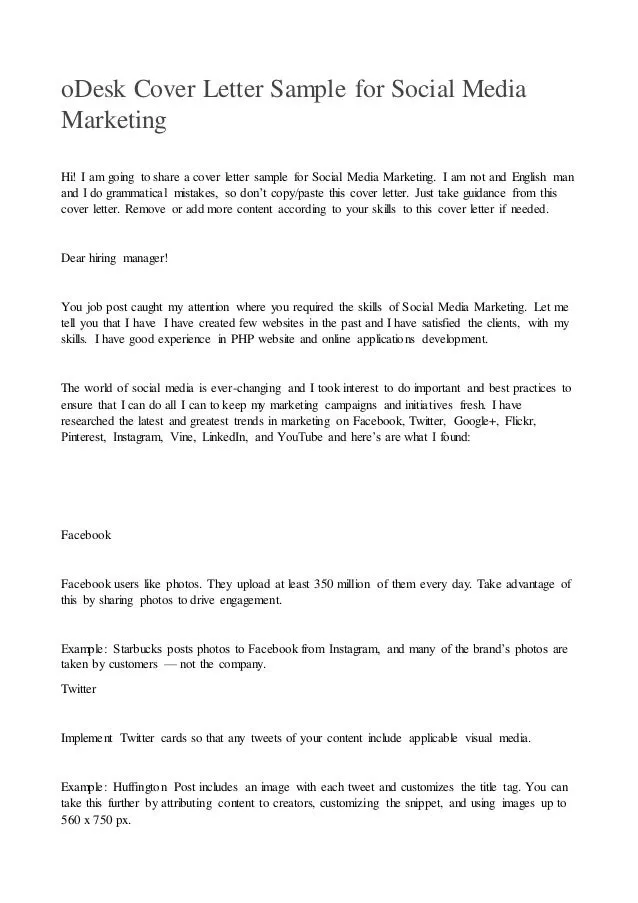
Every cover letter should be tailored to the specific job you’re applying for. This involves carefully reading the job description and identifying the key skills and experiences the employer is seeking. Then, align your cover letter with those requirements, highlighting the experiences and skills that match the job description. If the job emphasizes a specific platform or skill, make sure to address it directly. Show the hiring manager that you understand the company’s needs and that you have the relevant skills. Avoid a generic cover letter, and instead, demonstrate your understanding of what the employer is looking for. Customization is crucial, as it directly addresses the job requirements.
Researching the Company Culture
Before you start writing, research the company. Visit their website, social media profiles, and any other online resources to learn about their brand, values, and target audience. This information will help you tailor your cover letter to the company’s culture. Demonstrate your understanding of their brand voice and social media strategy by mentioning specific campaigns or content pieces that resonate with you. Showing that you have done your homework demonstrates your genuine interest in the company and increases your chances of making a positive impression. Researching the company shows you’re not just applying for any job but are genuinely interested in their organization.
Using the Right Tone and Language
The tone and language of your cover letter should be professional, yet reflect your personality and passion for social media marketing. Use clear, concise language and avoid jargon. Show your enthusiasm for the role without being overly casual. Your writing should be engaging and easy to read. The tone should also align with the company’s brand. If the company has a more creative or informal brand voice, you can reflect that in your cover letter. Ensure your writing style suits the job. Moreover, maintain a balance between professionalism and authenticity. Your personality needs to be evident to create an engaging and appealing cover letter.
Formatting for Maximum Impact
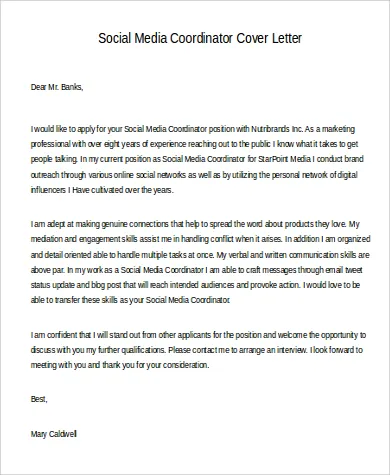
The format of your cover letter is equally important. Keep it concise, typically one page long. Use a professional font, such as Arial or Times New Roman, and ensure that your letter is well-organized with clear sections. Use bullet points, headings, and white space to make the letter easy to read. Include your contact information at the top of the letter, including your name, phone number, email address, and, if applicable, a link to your online portfolio or LinkedIn profile. This allows the recruiter easy access to your contact information. Make sure the cover letter is visually appealing and easy to scan. Proper formatting significantly impacts the first impression.
Key Elements of a Winning Cover Letter
A winning cover letter includes several key elements. Start with a strong opening that grabs the reader’s attention and clearly states the position you’re applying for. Highlight your relevant skills and experience, providing specific examples to back up your claims. Demonstrate your understanding of the company and the role. Quantify your achievements with data and metrics. Show your personality and passion for social media marketing. And, finally, include a call to action, expressing your eagerness to learn more and your availability for an interview.
Crafting a Strong Opening Statement
The opening of your cover letter is crucial as it sets the tone and grabs the hiring manager’s attention. Instead of a generic greeting, try something more engaging. State the position you are applying for and immediately express your enthusiasm for the role and the company. Briefly highlight a key skill or achievement that makes you a strong candidate. Avoid clichés like “I am writing to express my interest.” Instead, aim for a more personalized and attention-grabbing opening. For instance, if you are applying for a position at a company that values creativity, start by showcasing your creative skills.
Highlighting Social Media Marketing Skills
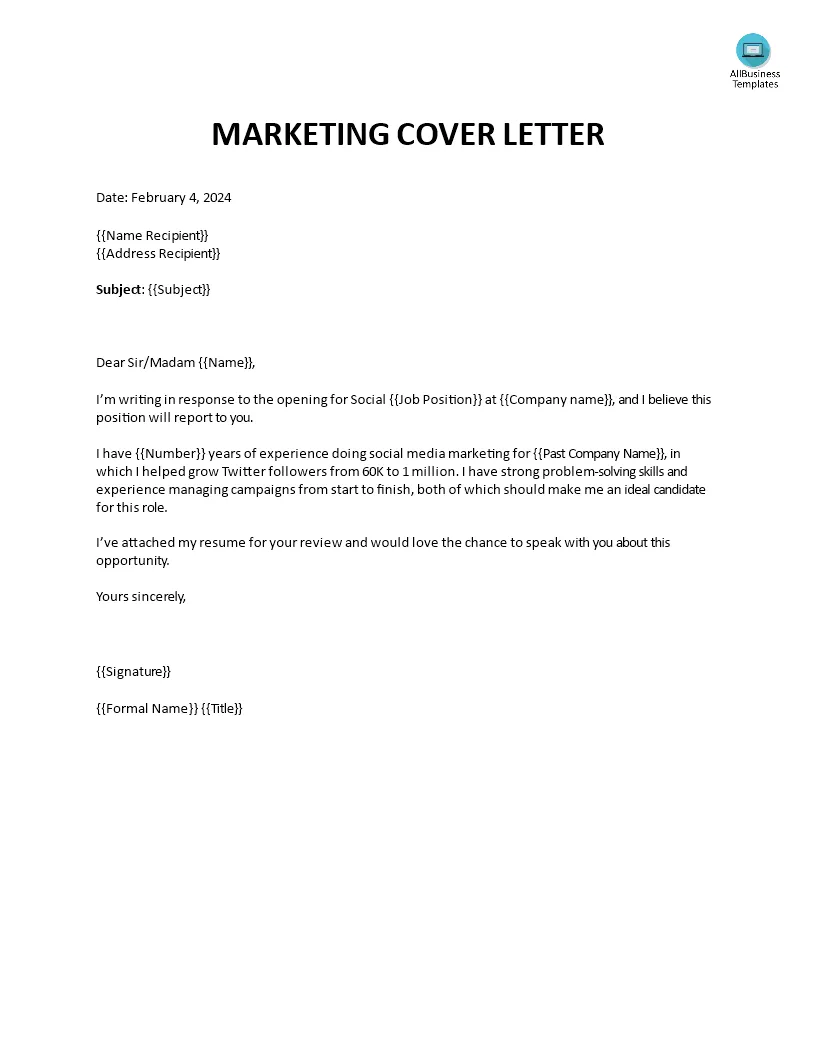
In your cover letter, provide specifics. Mention your knowledge of social media platforms. Include specific examples. For example, explain how you developed and executed a successful Facebook advertising campaign that increased leads by a certain percentage. Emphasize your understanding of social media analytics tools like Google Analytics. Describe your familiarity with content creation tools, such as Canva or Adobe Creative Suite. Detail your skills in creating engaging content. Tailor your skills to the job requirements, using the job description as a guide.
Demonstrating Relevant Experience
Focus on experience relevant to the social media marketing role you are applying for. Highlight previous roles, internships, or projects where you managed social media accounts, created content, analyzed data, or engaged with audiences. If you have managed social media for a specific brand or organization, mention the industry and size. Describe any campaigns or strategies you implemented. Use action verbs to describe your responsibilities. For instance, use words like “developed,” “managed,” “executed,” and “analyzed.” Detail the challenges you faced and the solutions you implemented. Mention any teamwork skills.
Emphasizing Achievements and Metrics
To make your cover letter stand out, highlight your achievements. Quantify your accomplishments whenever possible. Instead of saying, “Increased social media engagement,” state, “Increased engagement by 25% in three months through strategic content planning and audience targeting.” Use specific metrics, such as follower growth, engagement rates, click-through rates, and conversion rates. Showcase your ability to use data to measure the success of your social media efforts. If you have generated leads, increased website traffic, or boosted sales through social media, include these metrics. Make sure your achievements are relevant and demonstrate your ability to drive results.
Writing a Compelling Closing Statement
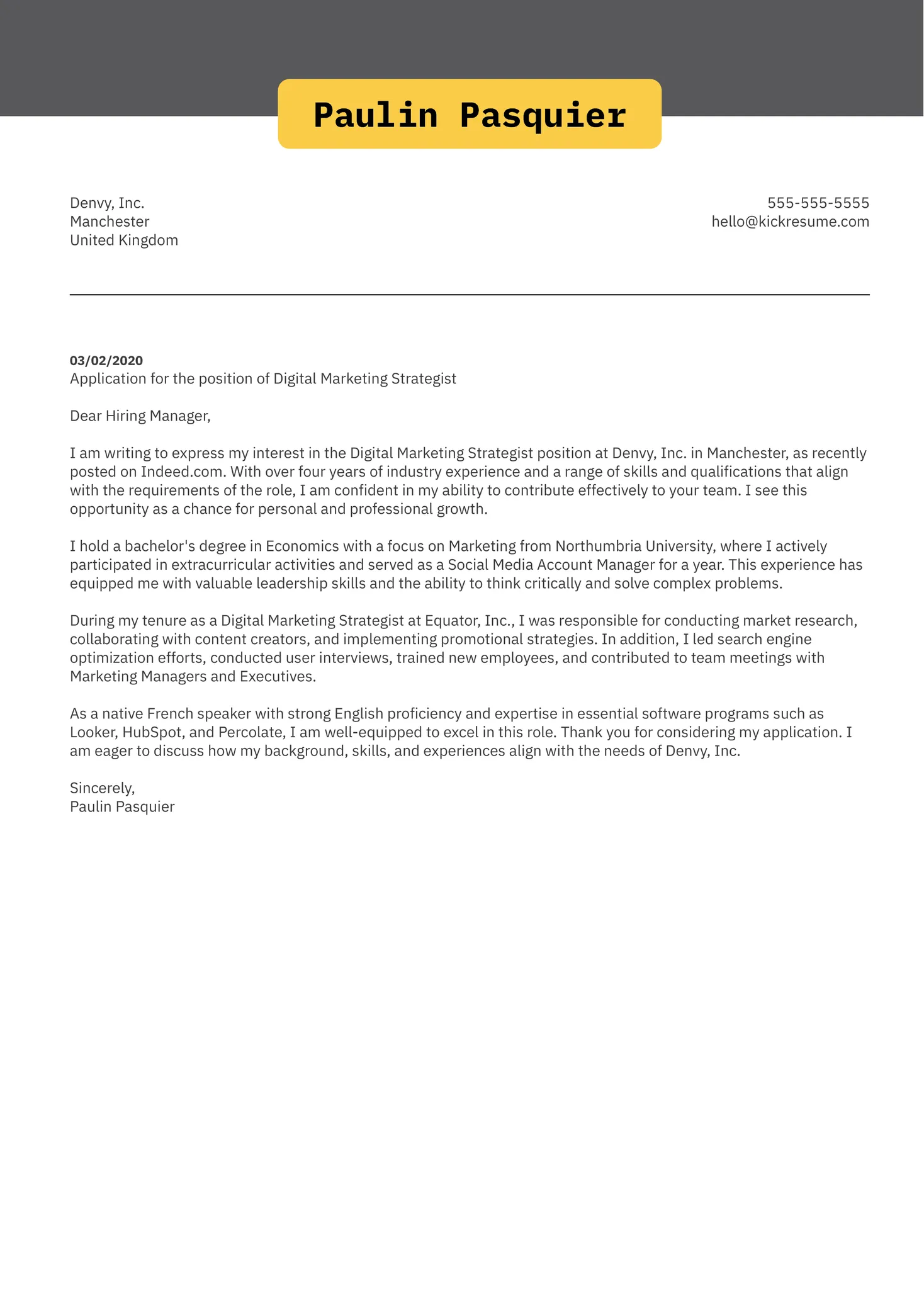
End your cover letter with a strong closing statement. Reiterate your interest in the role and the company. Express your enthusiasm for the opportunity to contribute to their success. Include a call to action, inviting the hiring manager to contact you for an interview. Make it clear that you are available and eager to discuss your qualifications further. Thank the hiring manager for their time and consideration. Proofread the closing statement to ensure it is free of errors and leaves a lasting positive impression.
Social Media Cover Letter Secrets
Creating a compelling social media marketing cover letter is an art. The letter must showcase your skills, experience, and personality. Tailor each letter to the specific job and company. Quantify your achievements, use the right tone, and proofread carefully. By following these secrets, you will stand out. A powerful cover letter can set you apart from the competition, boosting your job search.
Using Keywords Effectively
Incorporate relevant keywords from the job description into your cover letter. This is essential for helping your application get noticed by applicant tracking systems (ATS). Identify the key skills and qualifications the employer is looking for and include these terms naturally throughout your letter. Use the keywords in your skills section and when describing your experience. Avoid keyword stuffing, which can make your letter sound unnatural and less compelling. The goal is to demonstrate that you meet the job’s requirements.
Avoiding Common Mistakes
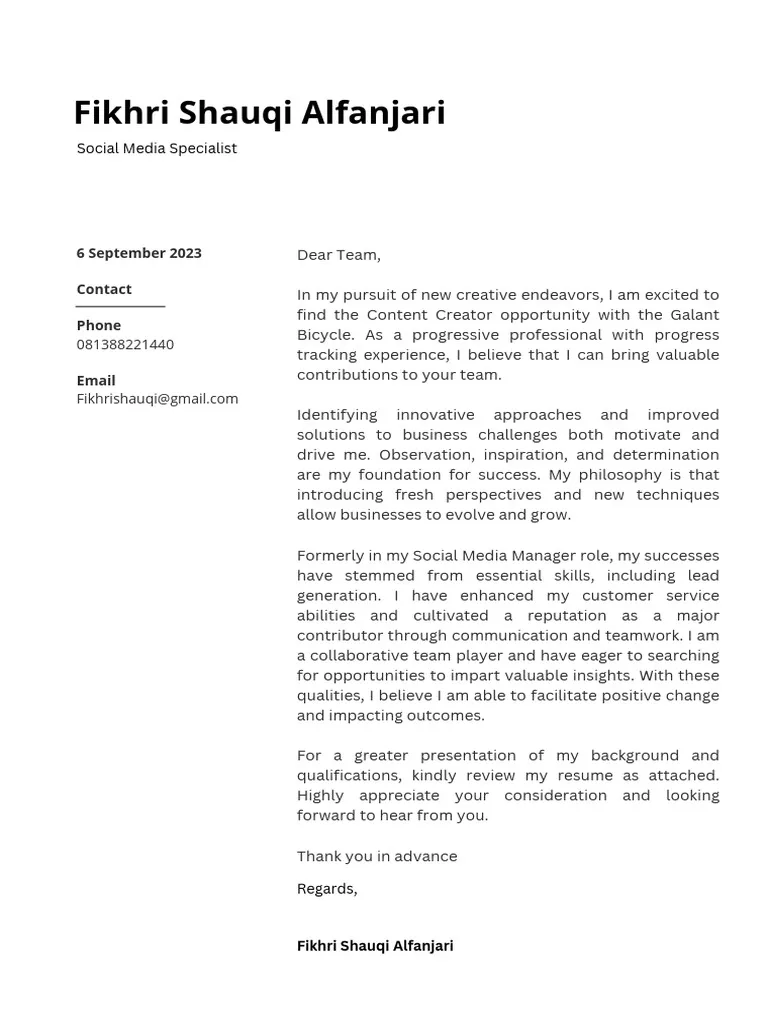
Be aware of and avoid these common cover letter mistakes. Don’t submit a generic cover letter. Failing to tailor your letter to the specific job shows a lack of interest. Avoid typos and grammatical errors, as they can undermine your credibility. Don’t use clichés. Avoid being overly formal or informal. Keep the letter concise. Don’t provide too much information. Finally, don’t neglect to proofread. These are important pitfalls to avoid. A careful, well-written cover letter can greatly improve your chances.
Proofreading and Editing
Before submitting your cover letter, carefully proofread and edit it. Check for any spelling, grammar, and punctuation errors. Ensure that your formatting is consistent. Consider asking a friend, mentor, or career counselor to review your cover letter. A fresh pair of eyes can catch mistakes you might have missed. A polished cover letter demonstrates attention to detail and professionalism. A well-edited cover letter enhances your credibility. It improves the quality of the application.
Examples of Successful Cover Letters
Reviewing successful cover letter examples can provide valuable insights and inspiration. Look for examples that are relevant to your experience level and the type of role you are seeking. Study how the writers highlight their skills, quantify their achievements, and tailor their letters to the job requirements. Use the examples to inform your own writing, but always personalize your letter to reflect your unique qualifications. By studying examples, you can learn effective techniques. Examples offer models for writing a compelling cover letter.
Example 1 Entry Level
A cover letter for an entry-level social media marketing position should emphasize your skills, education, and any relevant experience, even if it’s limited. Focus on the transferable skills you have, such as content creation, understanding social media platforms, and communication skills. Highlight any internships, volunteer work, or personal projects. Show enthusiasm and a willingness to learn and grow. Use this opportunity to showcase your motivation and passion for the field. Include any coursework or certifications. Mention relevant skills, like writing.
Example 2 Mid Level
A mid-level cover letter should highlight your experience, achievements, and leadership abilities. Focus on specific campaigns you’ve managed and the results you’ve achieved. Quantify your accomplishments with metrics and data. Describe your experience with social media analytics tools. Show your understanding of strategy development and execution. Highlight your ability to manage social media budgets. Include experience with various platforms. Discuss your ability to work independently or in a team.
Example 3 Senior Level
A senior-level cover letter should showcase your leadership experience, strategic thinking, and ability to drive results. Highlight your experience with leading social media teams and developing comprehensive social media strategies. Quantify your achievements. Demonstrate your experience with managing social media budgets. Show your knowledge of industry trends and best practices. Emphasize your ability to align social media strategies with business goals. Include examples of successful campaigns. Show your ability to provide leadership.
Adapting Your Letter for Different Roles
Adapt your cover letter to match the specific role you are applying for. A cover letter for a content creation role should highlight your writing skills, creativity, and experience in producing engaging content. A cover letter for a community management position should emphasize your ability to engage with audiences, build relationships, and manage online communities. A cover letter for an advertising role should focus on your experience with social media advertising platforms, campaign management, and data analysis. Consider the requirements of each role. Tailor the skills to the job description.
Cover Letters for Specific Social Media Platforms
Some social media marketing roles may require specific platform expertise. If the job description focuses on a specific platform like Instagram, Facebook, or TikTok, tailor your cover letter to emphasize your skills and experience on that platform. Discuss your understanding of platform-specific features, algorithms, and best practices. Highlight your ability to create platform-specific content and engage with audiences. Mention any relevant certifications or training you have. Demonstrate your knowledge of platform-specific tools. Mention the relevant experience for the platform.
Cover Letters for Content Creation Roles
When applying for a content creation role, focus on your writing skills, creativity, and ability to produce engaging content. Showcase your experience in creating various types of content, such as blog posts, social media captions, videos, and infographics. Include links to your portfolio or samples of your work. Mention any relevant software skills. Show your creativity and storytelling ability. Emphasize the skills needed for the role.
Cover Letters for Community Management Positions
For community management positions, emphasize your ability to engage with audiences, build relationships, and manage online communities. Highlight your experience in moderating online discussions, responding to comments and messages, and resolving customer issues. Demonstrate your understanding of social media etiquette and community guidelines. Mention your experience in building and maintaining positive relationships with community members. Showcase your communication skills.
The Importance of a Strong Portfolio
Your portfolio is a crucial part of your job application. Include a link to your online portfolio or attach samples of your work to your cover letter and resume. Your portfolio should showcase your best work, including examples of social media campaigns, content pieces, and other relevant projects. Make sure your portfolio is well-organized and easy to navigate. Include clear descriptions of your role in each project and the results you achieved. A strong portfolio enhances your application.
Tips for Portfolio Development
Here are some tips for developing a strong portfolio. Include a variety of work samples. Organize your portfolio. Make it visually appealing. Include clear descriptions of your projects. Provide metrics and results. Update your portfolio regularly. Include any case studies. This will allow you to showcase your best work. Focus on the most impactful work.
Showcasing Your Best Work
Showcase your best work in your cover letter. Choose the most relevant and impressive projects. Describe your role in each project. Highlight the results you achieved. Provide data and metrics to support your claims. Tailor your selections to match the job requirements. Your best work will capture the interest of the employer. This will enhance your application.
